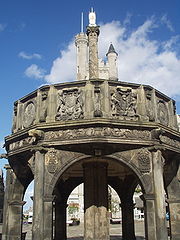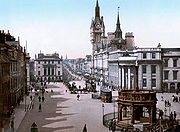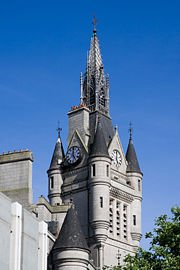
History of Aberdeen
Encyclopedia


Aberdeen
Aberdeen is Scotland's third most populous city, one of Scotland's 32 local government council areas and the United Kingdom's 25th most populous city, with an official population estimate of ....
, Scotland
Scotland
Scotland is a country that is part of the United Kingdom. Occupying the northern third of the island of Great Britain, it shares a border with England to the south and is bounded by the North Sea to the east, the Atlantic Ocean to the north and west, and the North Channel and Irish Sea to the...
is long and distinguished with a human presence in the area since the Stone Age
Stone Age
The Stone Age is a broad prehistoric period, lasting about 2.5 million years , during which humans and their predecessor species in the genus Homo, as well as the earlier partly contemporary genera Australopithecus and Paranthropus, widely used exclusively stone as their hard material in the...
. Aberdeen as a city, grew up as two separate burghs: Old Aberdeen
Old Aberdeen
Old Aberdeen is part of the city of Aberdeen in Scotland. Old Aberdeen was originally a separate burgh, which was erected into a burgh of barony on 26 December 1489. It was incorporated into adjacent Aberdeen by Act of Parliament in 1891...
at the mouth of the River Don
River Don, Aberdeenshire
The River Don is a river in north-east Scotland. It rises in the Grampians and flows eastwards, through Aberdeenshire, to the North Sea at Aberdeen. The Don passes through Alford, Kemnay, Inverurie, Kintore, and Dyce...
; and New Aberdeen, a fishing and trading settlement where the Denburn entered the Dee estuary.
Pre-1136
Aberdeen was first settled by hunter-gatherers around 6000BC, who established themselves around the mouths of the river DeeRiver Dee, Aberdeenshire
The River Dee is a river in Aberdeenshire, Scotland. It rises in the Cairngorms and flows through Strathdee to reach the North Sea at Aberdeen...
and river Don. Around 2000BC the Beaker People, who built the mysterious stone circles that can be found in the Aberdeenshire
Aberdeenshire
Aberdeenshire is one of the 32 unitary council areas in Scotland and a lieutenancy area.The present day Aberdeenshire council area does not include the City of Aberdeen, now a separate council area, from which its name derives. Together, the modern council area and the city formed historic...
area, arrived from the Rhine lands.
400BC saw Celtic migration to the area from the south of Scotland.
The Romans arrived in Aberdeenshire in the first century AD. Agricola
Gnaeus Julius Agricola
Gnaeus Julius Agricola was a Roman general responsible for much of the Roman conquest of Britain. His biography, the De vita et moribus Iulii Agricolae, was the first published work of his son-in-law, the historian Tacitus, and is the source for most of what is known about him.Born to a noted...
, the Roman governor of Britannia
Britannia
Britannia is an ancient term for Great Britain, and also a female personification of the island. The name is Latin, and derives from the Greek form Prettanike or Brettaniai, which originally designated a collection of islands with individual names, including Albion or Great Britain. However, by the...
, led a force of some 40,000 men into Caledonia
Caledonia
Caledonia is the Latinised form and name given by the Romans to the land in today's Scotland north of their province of Britannia, beyond the frontier of their empire...
in 84AD. They fought and defeated the united armies of the Picts
Picts
The Picts were a group of Late Iron Age and Early Mediaeval people living in what is now eastern and northern Scotland. There is an association with the distribution of brochs, place names beginning 'Pit-', for instance Pitlochry, and Pictish stones. They are recorded from before the Roman conquest...
in the Battle of Mons Graupius
Battle of Mons Graupius
According to Tacitus, the Battle of Mons Graupius took place in AD 83 or, less probably, 84. Gnaeus Julius Agricola, the Roman governor and Tacitus' father-in-law, had sent his fleet ahead to panic the Caledonians, and, with light infantry reinforced with British auxiliaries, reached the site,...
, near the peak of Bennachie
Bennachie
Bennachie is a range of hills in Aberdeenshire, Scotland. It has several tops, the highest of which, Oxen Craig, has a height of 528 m...
in Aberdeenshire.
After the Romans left, the natives of Aberdeenshire began to convert to Christianity. Aberdeen's first church was built around 580AD. St Kentigern sent St Machar to convert the Picts to Christianity. St Machar's Cathedral today is named after him.
1136 to the 18th Century
In 1136, David IDavid I of Scotland
David I or Dabíd mac Maíl Choluim was a 12th-century ruler who was Prince of the Cumbrians and later King of the Scots...
began the development of New Aberdeen north of the River Dee, and the earliest charter was granted by King William the Lion
William I of Scotland
William the Lion , sometimes styled William I, also known by the nickname Garbh, "the Rough", reigned as King of the Scots from 1165 to 1214...
about 1179, confirming the corporate rights granted by David I. The city received other royal charters later. In 1319, the Great Charter of Robert the Bruce
Robert I of Scotland
Robert I , popularly known as Robert the Bruce , was King of Scots from March 25, 1306, until his death in 1329.His paternal ancestors were of Scoto-Norman heritage , and...
transformed Aberdeen into a property owning and financially independent community. Bruce had a high regard for the citizens of Aberdeen who had sheltered him in his days of outlawry, helped him win the Battle of Barra and slew the English garrison at Aberdeen Castle
Aberdeen Castle
Aberdeen Castle was a late Middle Ages fortification, in Aberdeen, Scotland. It was situated on Castle Hill, a site today known as the Castlegate, where a block of flats are currently located....
. He granted Aberdeen with the nearby Forest of Stocket. The income from this land has formed the basis for the city's Common Good Fund, which is used to this day for the benefit of all Aberdonians.
The city was burned by Edward III of England
Edward III of England
Edward III was King of England from 1327 until his death and is noted for his military success. Restoring royal authority after the disastrous reign of his father, Edward II, Edward III went on to transform the Kingdom of England into one of the most formidable military powers in Europe...
in 1336, but was soon rebuilt and extended, and called New Aberdeen. For many centuries the city was subject to attacks by the neighbouring lords, and was strongly fortified, but the gates were all removed by 1770. In 1497 a blockhouse was built at the harbour mouth as a protection against the English. During the Wars
Wars of the Three Kingdoms
The Wars of the Three Kingdoms formed an intertwined series of conflicts that took place in England, Ireland, and Scotland between 1639 and 1651 after these three countries had come under the "Personal Rule" of the same monarch...
of 1644-47 between the Royalists and Covenanters the city was impartially plundered by both sides. In 1644, it was taken and sacked by Royalist troops consisting of Irishmen and Highlanders after the Battle of Aberdeen
Battle of Aberdeen
The Battle of Aberdeen was an engagement in the Wars of the Three Kingdoms which took place between Royalist and Covenanter forces outside the city of Aberdeen on 13 September 1644....
. 1647 saw the outbreak of bubonic plague
Bubonic plague
Plague is a deadly infectious disease that is caused by the enterobacteria Yersinia pestis, named after the French-Swiss bacteriologist Alexandre Yersin. Primarily carried by rodents and spread to humans via fleas, the disease is notorious throughout history, due to the unrivaled scale of death...
, and a quarter of the population died. In 1715 the Earl Marischal
Earl Marischal
The title of Earl Marischal was created in the peerage of Scotland for William Keith, the Great Marischal of Scotland.The office of "Marischal of Scotland" had been held heritably by the senior member of the Keith family since Hervey de Keith, who held the office of Marischal under Malcolm IV and...
proclaimed the Old Pretender at Aberdeen, and in 1745 the Duke of Cumberland
Prince William Augustus, Duke of Cumberland
Prince William , was a younger son of George II of Great Britain and Caroline of Ansbach, and Duke of Cumberland from 1726. He is generally best remembered for his role in putting down the Jacobite Rising at the Battle of Culloden in 1746, and as such is also known as "Butcher" Cumberland...
resided for a short time in the city before attacking the Young Pretender.
18th Century to Present Day
In the 18th century a new Town Hall was built, elegantly furnished with a marble fireplace from Holland and a set of fine crystal chandeliers and sconces. The latter are still a feature in the Town House. This century also saw the beginnings of social services for the InfirmaryAberdeen Royal Infirmary
Aberdeen Royal Infirmary or ARI is a teaching hospital on the Foresterhill site in Aberdeen, Scotland. It is run by NHS Grampian and has around 900 beds. ARI is a tertiary referral hospital serving a population of over 600,000 across the North of Scotland...
at Woolmanhill
Woolmanhill Hospital
-History:Opened in 1749, it was the original Aberdeen Royal Infirmary, before this was moved to the Foresterhill site.-Current Use:There are now no in-patient beds in Woolmanhill....
which was opened in 1742 and the Lunatic Asylum in 1779.
In the late 18th century, the council embarked on a scheme of road improvements, and by 1805 George Street, King Street and Union Street
Union Street, Aberdeen
Union Street is a major street and shopping thoroughfare in Aberdeen, Scotland.It was built, along with the adjoining King Street, in the beginning of the 19th Century under plans suggested by Charles Abercrombie to provide an impressive entrance way into the city, and nearly bankrupted the city...
were open, the latter a feat of extraordinary engineering skill involving the partial levelling of St Catherine's Hill and the building of arches to carry the street over Putachieside. The Denburn Valley was crossed by Union Street with a single span arch of 130 ft (40 m). Along these new streets was built the nucleus of the Granite City, many of whose buildings were designed by John Smith and Archibald Simpson
Archibald Simpson
Archibald Simpson was one of the major architects of Aberdeen, .Simpson's buildings have contributed significantly to the architecture of Aberdeen. His first commission was for St...
.

Napoleonic Wars
The Napoleonic Wars were a series of wars declared against Napoleon's French Empire by opposing coalitions that ran from 1803 to 1815. As a continuation of the wars sparked by the French Revolution of 1789, they revolutionised European armies and played out on an unprecedented scale, mainly due to...
. Improvements in street lighting came in 1824 with the advent of gas, and a vast improvement was made to the water supply in 1830 when water was pumped from the Dee to a reservoir in Union Place. An underground sewerage system was begun in 1865 to replace the open sewers which previously ran along certain streets.
The city was the headquarters of the Great North of Scotland Railway
Great North of Scotland Railway
The Great North of Scotland Railway was one of the smaller Scottish railways before the grouping, operating in the far north-east of the country. It was formed in 1845 and received its Parliamentary approval on June 26, 1846, following over two years of local meetings...
, located at 89 Guild Street, which was formed in 1846, becoming one of the constituents of the London and North Eastern Railway
London and North Eastern Railway
The London and North Eastern Railway was the second-largest of the "Big Four" railway companies created by the Railways Act 1921 in Britain...
in 1923. The city was formerly served by Aberdeen Corporation Tramways
Aberdeen Corporation Tramways
-The system:The city's tram system was the most northerly municipal tramway in the United Kingdom. The system was electrified, with trams using bow collectors to take power from the overhead wires...
, which closed in 1958.
In 1943 during World War II, a Luftwaffe raid dropped 129 bombs on Aberdeen resulting in 125 deaths and considerable damage to the city. This event is referred to as the Aberdeen Blitz.
In 1964 a food poisoning outbreak occurred, this was due to the sale of contaminated meat from a shop (William Low & Co) which was on Union Street.http://www.martinfrost.ws/htmlfiles/july2008/typhoid_fever.html The disease was typhoid.http://www.historyandpolicy.org/papers/policy-paper-32.html After the food poisoning outbreak the food shop closed and in the late 1990s the site was occupied by a music shop (HMV
HMV
His Master's Voice is a trademark in the music business, and for many years was the name of a large record label. The name was coined in 1899 as the title of a painting of the dog Nipper listening to a wind-up gramophone...
). The name of the report of the government enquiry is the "Milne Report".
The city was first incorporated in 1891. By 1901 the population was 153,000 and the city covered more than 6,000 acres (24 km²).
Today, although Old Aberdeen still has a separate charter and history, it and New Aberdeen are no longer truly distinct. The area of the city now includes the former burghs of Old Aberdeen, New Aberdeen, Woodside
Woodside, Aberdeen
Woodside is a part of the city of Aberdeen, Scotland, United Kingdom.The area used to be separate from the city but was incorporated in 1891....
and the Royal Burgh
Royal burgh
A royal burgh was a type of Scottish burgh which had been founded by, or subsequently granted, a royal charter. Although abolished in 1975, the term is still used in many of the former burghs....
of Torry
Torry
-Setting and historical development:Torry, lying on the south bank of the River Dee, was once a Royal Burgh in its own right, having been erected a burgh of barony in 1495. It was incorporated into Aberdeen in 1891, after the construction of the Victoria Bridge, itself made possible by the 1871...
to the south of River Dee.

